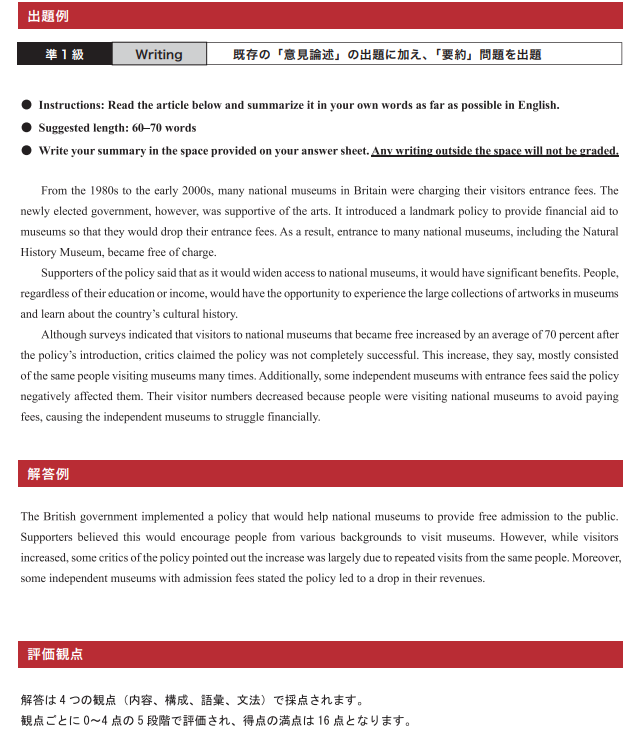アメリカ人が毎日使うスラング・イディオムを学ぶ!
ネイティブのように話せるようになるのも”in no time”(あっという間)!

ネイティブのリアル英語 flunk 落第する、赤点を取る
「(試験・テストで)赤点を取る」はスラング英語で “flunk” と言います。
flunk a classで「単位を落とす」、flunk a examで「赤点を取る」
flunkは「しくじる」という意味を持つので、flunk a yearと言えば留年ということになりますし、3年生で留年したなら
”flunk a 3rd grade” と言います。

I don’t want to flunk one year.
俺は留年したくないよ。
He’s flunked the entrance exam once and flunked a year three times.
彼は1浪3留である。
┃ 例文
He flunked the entrance exam, so he didn’t go to university.
彼は入学試験に落ちたので大学に行かなかった。
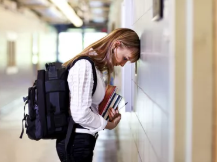
I’ve decided to flunk a student in my class.
私が教えているクラスの学生を一人不合格にすることにしました。
「flunk(単位を落とす・赤点を取る) 」習得・攻略
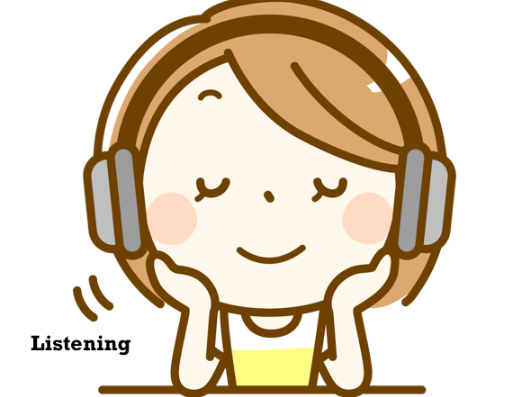
ネイティブのリアル 英語:
I studied all night for this test! How could I have possibly flunked?

学校で教わる英語:
I studied all night for this test! How could I have possibly failed?
ネイティブのリアル発音:
I studied all night fer this test! How could I’ev possibly flunked?
Flunk を使ったその他のイディオム
Flunk out : 学校を退学になる
He flunked out of college after failing all his courses.
彼は全ての科目で不合格だったため、大学を退学になった。
Flunk a test/exam : 試験に落ちる
I didn’t study enough and flunked the math test.
十分に勉強しなかったので、数学の試験に落ちてしまった。
Flunk a class/course : 授業・コースで失敗する
If she flunks the course, she might have to repeat the year.
彼女がそのコースで失敗すれば、年度をやり直さなければならないかもしれない。

Flunk someone (as a teacher) : (教師が)生徒に不合格をつける
The teacher flunked him because he didn’t submit any of his assignments.彼が課題を一つも提出しなかったため、教師は彼に不合格をつけた。
Barely pass (opposite of flunk) : かろうじて合格する(「flunk」の反対)
I was so relieved to barely pass the chemistry exam, I thought I would flunk.
化学の試験でかろうじて合格して安堵した。落ちると思っていたから。
On the verge of flunking : 落第寸前
例文: “She is on the verge of flunking her history class if she doesn’t improve her grades.”
和訳: 「彼女は成績を上げなければ歴史の授業を落第寸前だ。」
Flunk an interview : 面接で不合格になる
He was so nervous that he flunked the job interview.
彼は緊張しすぎて、仕事の面接に不合格だった。

同義表現
to fail a test or a subject
▮ レッスンの特徴
小中学生、一般初級者対象に身近なことや社会問題について講師とディスカッション。
様々なトピックについて英語で自分の意見・主張が話せるようになります。
レッスン時間は、トピックについてのスピーキングが中心になります。
● You have received an email question from a foreign acquaintance, Alex. Write a reply in English in the ‘Answer Box’, clearly answering this question.
● In your reply email, regarding the underlined parts in Alex’s email, ask two specific questions to deepen your understanding of the underlined features.
● The English text you write in the ‘Answer Box’ should ideally be between 40 to 50 words.
● Any text written outside the ‘Answer Box’ will not be graded.
● If your answer is deemed not to correspond to Alex’s email, it may be scored as zero points. Please read the content of Alex’s email carefully before answering.
● You do not need to write your name after ‘Best wishes,’ at the bottom of the ‘Answer Box’.”
=======================================
Lesson 1.
Hi!
I’m working on a school project about traditional celebrations around the world. Next week, I have to present about “New Year’s Eve celebrations” in different cultures. I remember you mentioning how special it is in your country. Could you tell me more about how you celebrate it? Are there any unique traditions or foods involved? I’m really excited to learn and share this information!
Your friend,
Alex
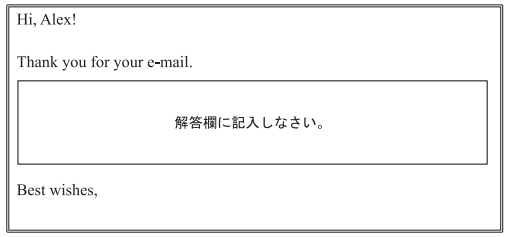
====================================================
Lesson 2
Hi!
For my world cultures class, we’re discussing “traditional family gatherings” around the globe. I remember you mentioned that family plays a big role in your culture. Could you share more about a typical family gathering in your country? What activities do you do, and are there any special dishes that are always prepared? I’m eager to learn and compare it with our traditions!
Best regard

=============================================================
Lesson 3
Hi!
I’ve been exploring various global music genres and I’m intrigued by traditional Japanese music. I’ve heard a little about the “koto and shamisen.” Could you explain more about these instruments and the type of music they’re used in?
Your friend,
Alex

=================================================================
Lesson 4.
Hi!
I’m working on a project about global food culture. I’m curious about “Japanese street food.” What are some popular street foods in Japan, and how do they reflect the local culture and lifestyle?
Your friend,
Alex
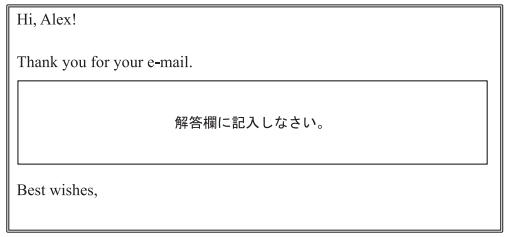
================================================
Lesson 5
Hi!
I’m working on a tourism project and focusing on inbound travel to Japan. I’m curious about the “attractions and experiences” that draw international visitors to Japan’s ancient capitals like Kyoto and Nara. What makes them so appealing to tourists?
Your friend,
Alex
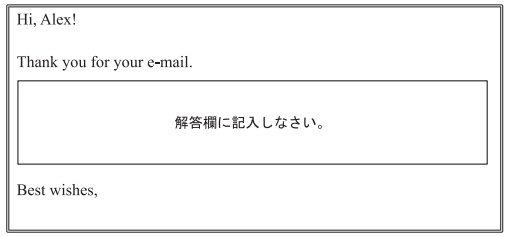
======================================================
Lesson 6.
Hi!
I recently tried conveyor belt sushi for the first time and loved it! I’m interested in “the history and popularity” of this dining style in Japan. How did it start, and why do you think it became so popular, both in Japan and globally?
Your friend,
Alex
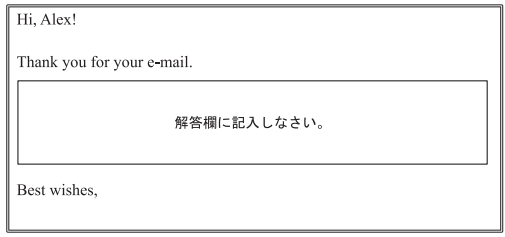
=======================================================
Lesson 7.
Hi!
I’m planning a winter trip to Japan and I’m really excited about visiting hot springs. Can you tell me about the “cultural significance and etiquette” of hot springs in Japan? I want to make sure I respect the traditions.
Your friend,
Alex
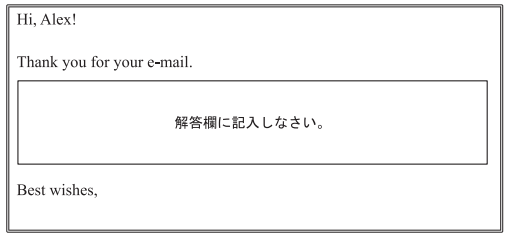
========================================================
Lesson 8.
Hi!
I’ve noticed that SNS platforms are used differently in Japan compared to my country. I’m curious about the “role and impact” of SNS in Japanese society. How do people in Japan typically use these platforms, and what’s their influence on daily life?
Your friend,
Alex
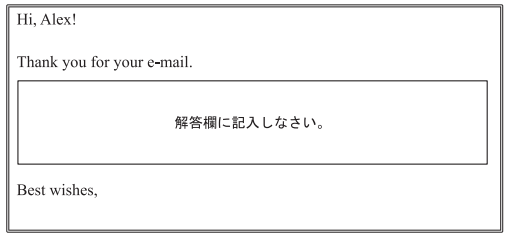
=======================================================
Lesson 9
Hi!
I’m fascinated by the firework displays I’ve seen in Japanese dramas. I heard summer fireworks are a big thing in Japan. Can you tell me more about the “tradition and significance” of fireworks in Japanese culture? What do they symbolize?
Your friend,
Alex
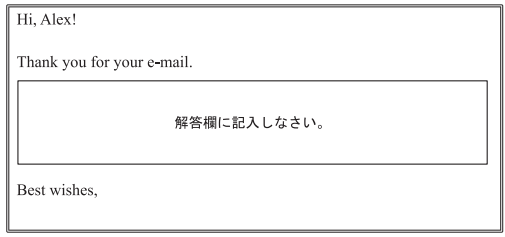
==========================================================
Lesson 10
Hi!
I’m amazed at how smartphones have changed daily life globally. I’m interested in “the impact of smartphones on Japanese society.” How have smartphones, or ‘smaho’, influenced lifestyle, work, and communication in Japan?
Your friend,
Alex
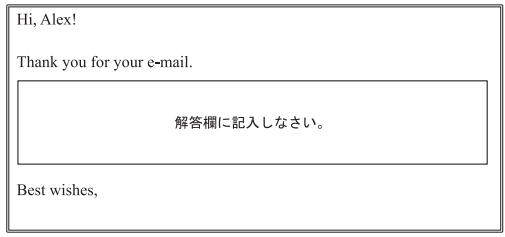
===================================================
Lesson 11
Hi!
I’m a big fan of smartphone games and I know Japan has a huge market for them. Can you tell me about the “popularity and trends” of smaho games in Japan? What makes them so appealing, and which are the most popular?
Your friend,
Alex
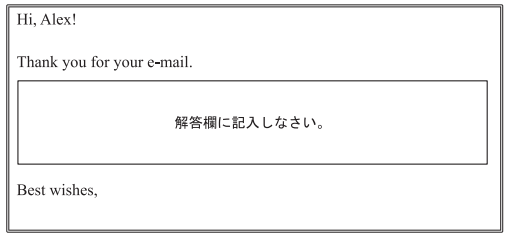
===================================================
Lesson 12.
Hi!
Autumn in Japan seems beautiful, especially with the autumn leaves. I’m planning a trip to experience this. Can you suggest the “best places and times” to see the autumn leaves? I want to capture the most scenic views.
Your friend,
Alex
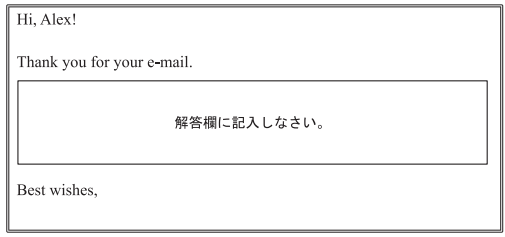
Model Answer:
Viewing autumn leaves in Japan is a wonderful experience. Are you looking for spots in the mountains or in cities? Also, which part of Japan are you planning to visit? Kyoto and Hokkaido are famous for their autumn scenery, best viewed from mid-October to late November.
====================================================
Lesson 13
Hi!
I’m doing a project on global responses to intense heat and climate change. I’ve heard Japan experiences intense heat in summer. Can you tell me about “measures and adaptations” in Japan to cope with high temperatures? How do people stay cool?
Your friend,
Alex
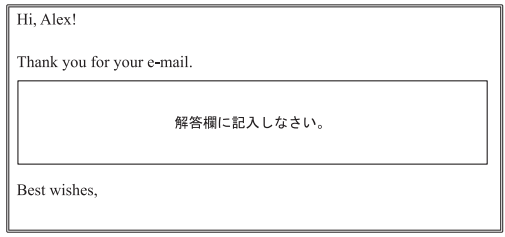
======================================================
Lesson 14.
Hi!
I’m a huge baseball fan and I’ve heard that it’s very popular in Japan too. I’m especially interested in Shohei Ohtani’s career. Can you tell me about the “popularity of baseball” in Japan and how players like Ohtani have influenced the sport?
Your friend,
Alex
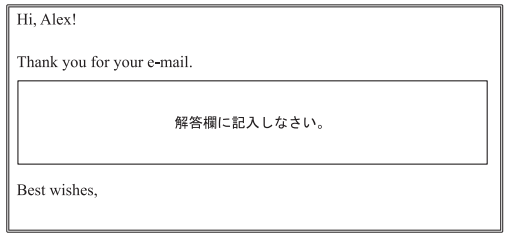
=======================================================
Lesson 15
Hi!
I’m part of a school club that’s creating a guide on “leisure activities worldwide.” Could you tell me about popular leisure activities in your country? What do people typically do in their free time? Are there any activities that are unique to your culture or region? Understanding how people relax and enjoy themselves in different parts of the world is fascinating to me. I’m excited to learn more about your country’s leisure culture.
Best,
Alex
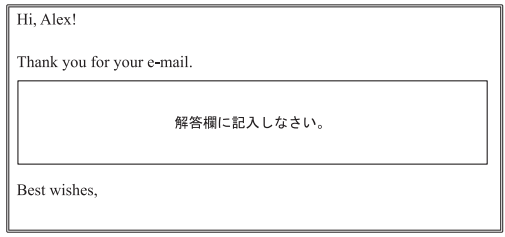
===============================================
Lesson 16.
Hi!
In my world cultures class, we’re exploring “traditional family roles.” Could you share how family roles are typically viewed in your country? Are there specific responsibilities or expectations for different family members? Also, have these roles changed over time, or do they remain deeply rooted in tradition? I’m curious about the similarities and differences in family dynamics globally. Your perspective would be really helpful for my class project.
Best regards,
Alex
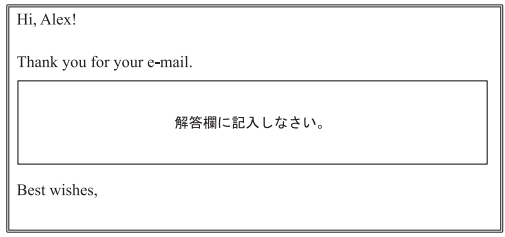
===================================================
Lesson 17.
Hi!
For my environmental studies course, we’re researching “urban green spaces” around the world. I’d like to know about the parks or public gardens in your city. How do these spaces impact urban life? Are they widely used by residents? Additionally, are there any unique features or conservation efforts associated with these green spaces? Learning about different approaches to urban nature is crucial for our study on sustainable city living.
Many thanks,
Alex
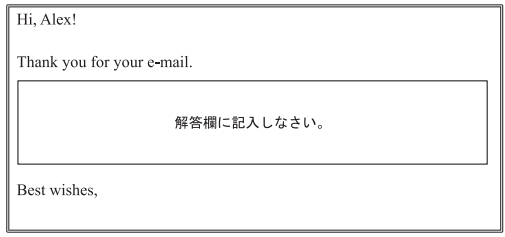
=================================================
Lesson 18.
Hi!
I’m working on a sociology project about “community events and festivals.” What are some significant community events or festivals in your country? How do they bring people together, and what activities are involved? Also, do these events have historical or cultural significance? Understanding how communities celebrate and bond is essential to my project. I’d really appreciate it if you could share some details about the festivals and events that are important in your society.
Kind regards,
Alex
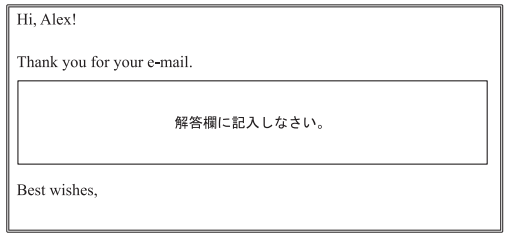
===================================================
Lesson 19.
I’m excited about the upcoming school festival. Our class decided to have a “Japanese tea ceremony” booth. It’s a big part of our culture, but I’m not sure about the correct steps. Can you tell me more about how to prepare and present the tea properly?
Your friend,
Alex
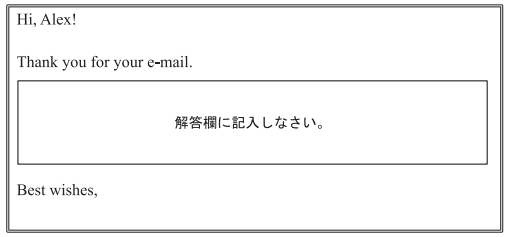
================================================
Lesson 20.
Hi!
In my global health class, we’re discussing “dietary habits and health.” What are common dietary habits in your country? How do these habits relate to overall health and wellness? Are there any specific foods or eating patterns that are particularly emphasized? It’s fascinating to see the connection between diet and health in different cultures. Any information you share will be valuable for my class discussion.
Best,
Alex
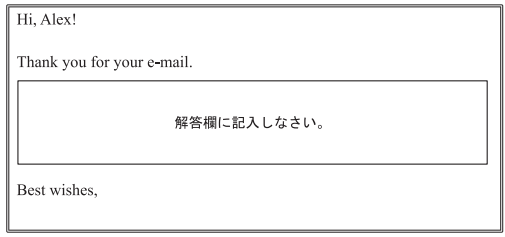
==================================================
Lesson 21.
Hi!
I’ve been watching a lot of historical movies lately. They made me curious about samurai culture. What’s the most fascinating aspect of “samurai history” for you? I’d love to learn more from a local perspective.
Your friend,
Alex
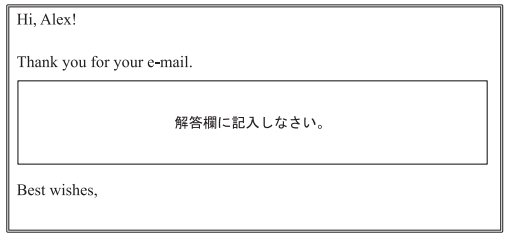
=====================================================
Lesson 22.
Hi!
I’m creating a presentation about “unique celebrations” around the world. I remember you mentioning a special festival in your country. Could you describe what makes this festival unique? What activities are involved, and is there special food or music? Also, how do people in your community prepare for it? I’m excited to include this in my presentation to highlight cultural diversity.
Best,
Alex
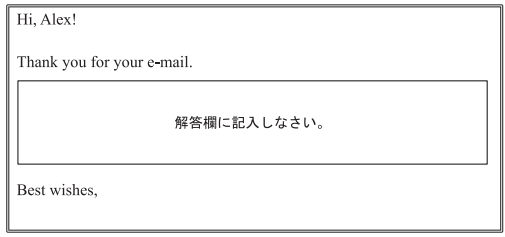
===================================================
Lesson 23.
Hi!
I’m part of a project studying “traditional games” from different countries. Could you tell me about a popular traditional game in your country? How is it played and what are the rules? Also, does this game have any cultural or historical significance? I find it fascinating how games reflect cultural values. Any details you provide will be valuable for understanding the cultural context of these games.
Thanks,
Alex
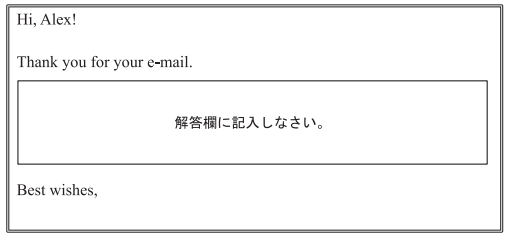
==================================================
lesson 24.
Hi!
For my art class, we’re exploring “street art in different cultures.” I’m curious about the street art scene in your city. What themes do artists typically explore, and are there any famous murals or artists? Also, how is street art perceived in your community? Is it seen as a form of expression or merely graffiti? Understanding different perspectives on street art will add depth to my project.
Kind regards,
Alex
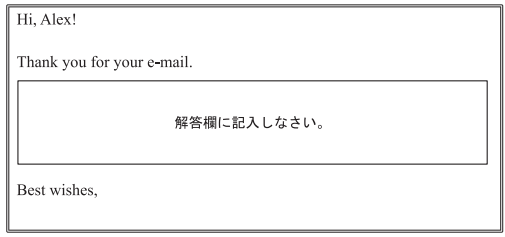
==================================================
lesson 25.
Hi!
For my science project, I’m focusing on renewable energy sources. I heard Japan is doing a lot in this field. Can you share some insights on “Japan’s approach to renewable energy”? I think it could really help my project.
Your friend,
Alex
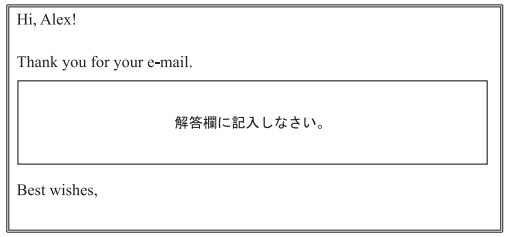
================================================
Lesson 26.
Hi!
I’m planning to visit Japan next summer. I want to explore both the urban and rural areas. Do you have any recommendations for “must-visit places” in Japan that are not too touristy? I’d like to experience the authentic Japanese lifestyle.
Your friend,
Alex
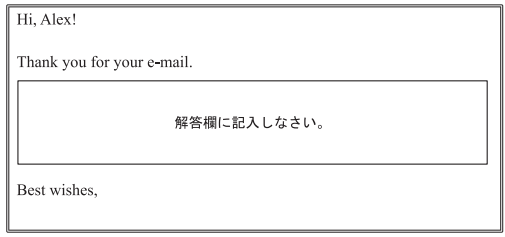
=================================================
Lesson 27
Hi!
I’ve been trying to learn Japanese by watching anime. It’s fun, but I’m not sure if it’s effective. What do you think about “learning a language through media”? Do you have any tips for making it more effective?
Your friend,
Alex
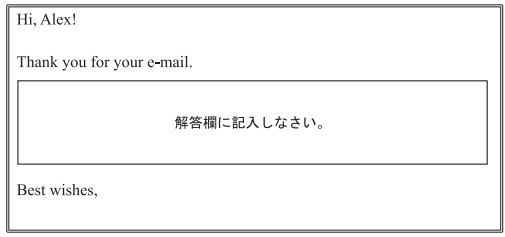
==================================================
Lesson 28
Hi!
I’m doing a project on global fashion trends and how they influence local styles. Japan seems to have a unique fashion scene. Can you tell me more about “Japan’s current fashion trends”? I’m curious about the youth culture.
Your friend,
Alex
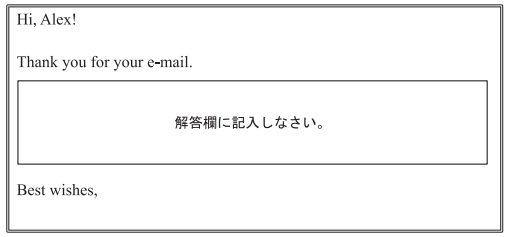
================================================
Lesson 29
Hi!
I just read about Japan’s advanced technology in robotics and AI. It’s fascinating! Can you tell me how this technology is “integrated into everyday life” in Japan? I’m curious about its impact on daily activities.
Your friend,
Alex
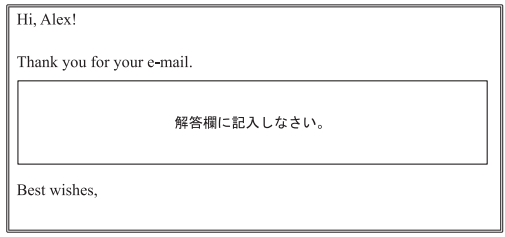
=================================================
Lesson 30
Hi!
Our school’s sports club is interested in learning about traditional Japanese sports. We know about sumo, but are there any other “traditional sports” we should explore? I think it would be great for our cultural exchange program.
Your friend,
Alex
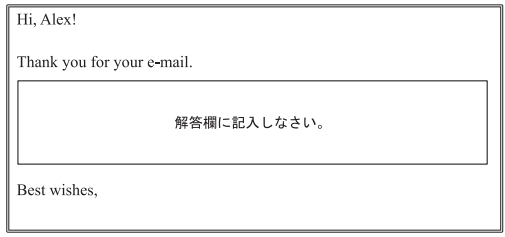
===================================================
Lesson 31
Hi!
In my world literature class, we’re discussing Japanese poetry. I find the structure of “haiku and tanka” poems fascinating. Could you explain the key differences between these two forms and their role in Japanese literature?
Your friend,
Alex
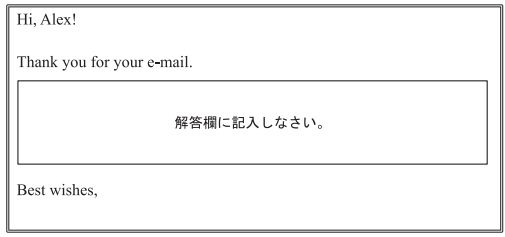
=================================================
Lesson 32
Hi!
I’m working on a cultural exchange program and researching “holiday traditions.” Can you share how you celebrate a major holiday in your country? What are the typical customs, foods, and activities? Also, has the way this holiday is celebrated changed in recent years? I’m eager to learn about the blend of tradition and modernity in holiday celebrations.
Kind regards,
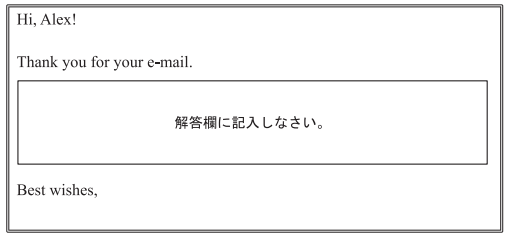
================================================
Lesson 33
Hi!
In my music appreciation class, we’re studying “instruments unique to different cultures.” I’m interested in learning about a musical instrument that’s special to your country. Can you describe its appearance, how it’s played, and the type of music it’s used for? Also, is it still commonly used today, or is it more of a historical instrument?
Thanks a lot,
Alex
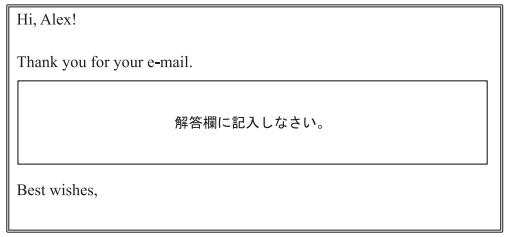
==========================================================
Lesson 34
Hi!
For my world literature class, we’re exploring “famous authors and their impact.” Could you tell me about a renowned author from your country? What are their most notable works, and why are they significant? Also, how have their writings influenced your country’s literature and culture? I’m fascinated by how authors can shape cultural and literary landscapes.
Best wishes,
Alex
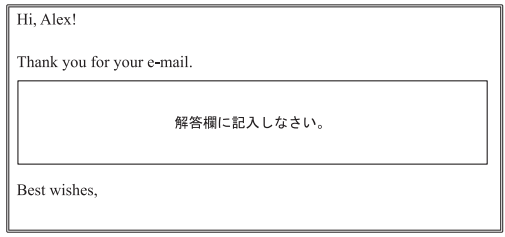
=====================================================
Lesson 35
Hi!
For my art class, I’m doing a project on contemporary Japanese artists. I’m particularly interested in those who blend traditional and modern styles. Could you tell me about some “influential contemporary artists” in Japan and their works?
Your friend,
Alex
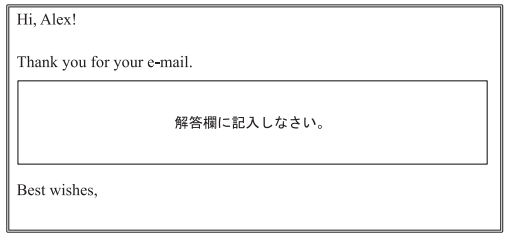
=========================================================
Lesson 36
Hi!
In my social studies class, we’re discussing “community service and volunteerism.” What types of community service initiatives are common in your country? How do people get involved, and what impact do these initiatives have? Also, is volunteerism widely encouraged or practiced? Learning about community engagement in different cultures is crucial for our understanding of global social responsibility.
Best,
Alex
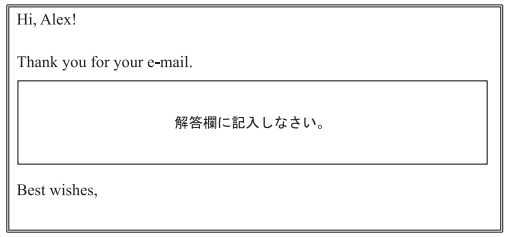
===================================================
Lesson 37
Hi!
In my world religions class, we’re learning about “religious festivals and their significance.” Could you describe a major religious festival in your country? What are the customs and rituals involved, and what is its spiritual significance? Also, how does this festival bring together the community? I’m interested in how religious observances foster community and cultural identity.
Sincerely,
Alex
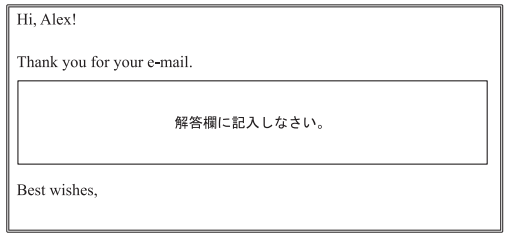
==============================================
Lesson 38
Hi!
I’m working on a project about technological advancements in healthcare. I’ve read that Japan is leading in this area. Can you tell me about some “innovative technologies or practices” in Japanese healthcare? I’m particularly interested in how they improve patient care.
Your friend,
Alex
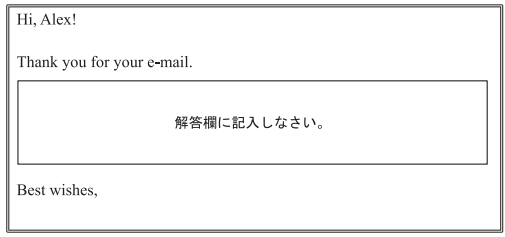
==================================================
Lesson 39
Hi!
I’m curious about Japan’s approach to space exploration. I know Japan has made significant contributions, but I’d like to know more about “recent projects or advancements” in Japanese space research. Can you share some details?
Your friend,
Alex
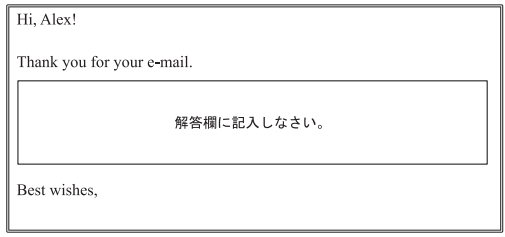
====================================================
Lesson 40
Hi!
I’m planning a school project on global animation industries. Japanese anime seems to have a huge global influence. Can you discuss “the evolution and impact” of anime in Japan and worldwide? I’m interested in its cultural significance.
Your friend,
Alex
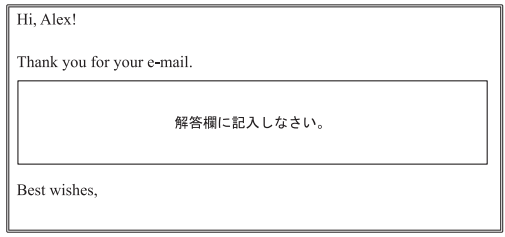
============================================-=====
▮ Lesson Course Name: EIKEN Grade Pre-2 Writing E-mail Task
▮ Number of Lessons: 40 Lessons – 40 Questions [Standard: 1 question = 1 lesson (25 minutes)]
(Please attend as many lessons as you need, based on your judgement.)
▮ Features: Original teaching materials. Uses questions similar to those in exams.
▮ Overview of the Lessons:
Preparatory Style: Students create their answer texts as part of their preparation. During the lesson, the instructor will revise and advise on these texts, developing model answers based on them.
Practical Style: Similar to the actual exam, students will create their answer texts without prior preparation, guided by the instructor, who will then revise and advise, helping to develop model answers.
*Note: Answers will be revised based on three criteria: content, vocabulary, and grammar.
━━ How the Lessons Proceed ━━
① Pre-study is recommended. Prepare your answer text in a Word document or similar file.
(If you prefer the same tension as in the actual test, proceed without pre-study.)
② Typically, one question will be covered in 25 minutes (one session).
③ In the lesson, students will drop their prepared answer text into the instructor’s chat box.
The instructor will revise the text sentence by sentence, showing it on the shared screen to the student.
At the end, the instructor will provide overall advice on the completed text.
Points for Email Tasks
- Read the instructions carefully and adhere strictly to them.
- Complete tasks such as ‘answering two questions’.
- Respond to the questions in the sender’s email.
※ Instructors, please receive the Answer Key from the manager.
●あなたは.外国人の知り合い(Alex)から.E メールで質問を受け取りました(一か所に”下線部”があります。この質問にわかりやすく答える返信メールを,「解答記入欄」に英文で書きなさい。
●あなたが書く返信メールの中で,AlexのEメール文中の “下線部” について,あなたがより理解を深めるために,”下線部” の特長を問う具体的な質問を2つしなさい。
●あなたが書く返信メールの中で 「解答記入欄」に書く英文の語数の目安は40 語~50 語です。
●「解答記入欄」の下の Best wishes, の後にあなたの名前を書く必要はありません。
=======================================
Lesson 1.
Hi!
I’m working on a school project about traditional celebrations around the world. Next week, I have to present about “New Year’s Eve celebrations” in different cultures. I remember you mentioning how special it is in your country. Could you tell me more about how you celebrate it? Are there any unique traditions or foods involved? I’m really excited to learn and share this information!
Your friend,
Alex

====================================================
Lesson 2
Hi!
For my world cultures class, we’re discussing “traditional family gatherings” around the globe. I remember you mentioned that family plays a big role in your culture. Could you share more about a typical family gathering in your country? What activities do you do, and are there any special dishes that are always prepared? I’m eager to learn and compare it with our traditions!
Best regard

=============================================================
Lesson 3
Hi!
I’ve been exploring various global music genres and I’m intrigued by traditional Japanese music. I’ve heard a little about the “koto and shamisen.” Could you explain more about these instruments and the type of music they’re used in?
Your friend,
Alex

=================================================================
Lesson 4.
Hi!
I’m working on a project about global food culture. I’m curious about “Japanese street food.” What are some popular street foods in Japan, and how do they reflect the local culture and lifestyle?
Your friend,
Alex

================================================
Lesson 5
Hi!
I’m working on a tourism project and focusing on inbound travel to Japan. I’m curious about the “attractions and experiences” that draw international visitors to Japan’s ancient capitals like Kyoto and Nara. What makes them so appealing to tourists?
Your friend,
Alex

======================================================
Lesson 6.
Hi!
I recently tried conveyor belt sushi for the first time and loved it! I’m interested in “the history and popularity” of this dining style in Japan. How did it start, and why do you think it became so popular, both in Japan and globally?
Your friend,
Alex

=======================================================
Lesson 7.
Hi!
I’m planning a winter trip to Japan and I’m really excited about visiting hot springs. Can you tell me about the “cultural significance and etiquette” of hot springs in Japan? I want to make sure I respect the traditions.
Your friend,
Alex

========================================================
Lesson 8.
Hi!
I’ve noticed that SNS platforms are used differently in Japan compared to my country. I’m curious about the “role and impact” of SNS in Japanese society. How do people in Japan typically use these platforms, and what’s their influence on daily life?
Your friend,
Alex

=======================================================
Lesson 9
Hi!
I’m fascinated by the firework displays I’ve seen in Japanese dramas. I heard summer fireworks are a big thing in Japan. Can you tell me more about the “tradition and significance” of fireworks in Japanese culture? What do they symbolize?
Your friend,
Alex

==========================================================
Lesson 10
Hi!
I’m amazed at how smartphones have changed daily life globally. I’m interested in “the impact of smartphones on Japanese society.” How have smartphones, or ‘smaho’, influenced lifestyle, work, and communication in Japan?
Your friend,
Alex

===================================================
Lesson 11
Hi!
I’m a big fan of smartphone games and I know Japan has a huge market for them. Can you tell me about the “popularity and trends” of smaho games in Japan? What makes them so appealing, and which are the most popular?
Your friend,
Alex

===================================================
Lesson 12.
Hi!
Autumn in Japan seems beautiful, especially with the autumn leaves. I’m planning a trip to experience this. Can you suggest the “best places and times” to see the autumn leaves? I want to capture the most scenic views.
Your friend,
Alex

Model Answer:
Viewing autumn leaves in Japan is a wonderful experience. Are you looking for spots in the mountains or in cities? Also, which part of Japan are you planning to visit? Kyoto and Hokkaido are famous for their autumn scenery, best viewed from mid-October to late November.
====================================================
Lesson 13
Hi!
I’m doing a project on global responses to intense heat and climate change. I’ve heard Japan experiences intense heat in summer. Can you tell me about “measures and adaptations” in Japan to cope with high temperatures? How do people stay cool?
Your friend,
Alex

======================================================
Lesson 14.
Hi!
I’m a huge baseball fan and I’ve heard that it’s very popular in Japan too. I’m especially interested in Shohei Ohtani’s career. Can you tell me about the “popularity of baseball” in Japan and how players like Ohtani have influenced the sport?
Your friend,
Alex

=======================================================
Lesson 15
Hi!
I’m part of a school club that’s creating a guide on “leisure activities worldwide.” Could you tell me about popular leisure activities in your country? What do people typically do in their free time? Are there any activities that are unique to your culture or region? Understanding how people relax and enjoy themselves in different parts of the world is fascinating to me. I’m excited to learn more about your country’s leisure culture.
Best,
Alex

===============================================
Lesson 16.
Hi!
In my world cultures class, we’re exploring “traditional family roles.” Could you share how family roles are typically viewed in your country? Are there specific responsibilities or expectations for different family members? Also, have these roles changed over time, or do they remain deeply rooted in tradition? I’m curious about the similarities and differences in family dynamics globally. Your perspective would be really helpful for my class project.
Best regards,
Alex

===================================================
Lesson 17.
Hi!
For my environmental studies course, we’re researching “urban green spaces” around the world. I’d like to know about the parks or public gardens in your city. How do these spaces impact urban life? Are they widely used by residents? Additionally, are there any unique features or conservation efforts associated with these green spaces? Learning about different approaches to urban nature is crucial for our study on sustainable city living.
Many thanks,
Alex

=================================================
Lesson 18.
Hi!
I’m working on a sociology project about “community events and festivals.” What are some significant community events or festivals in your country? How do they bring people together, and what activities are involved? Also, do these events have historical or cultural significance? Understanding how communities celebrate and bond is essential to my project. I’d really appreciate it if you could share some details about the festivals and events that are important in your society.
Kind regards,
Alex

===================================================
Lesson 19.
I’m excited about the upcoming school festival. Our class decided to have a “Japanese tea ceremony” booth. It’s a big part of our culture, but I’m not sure about the correct steps. Can you tell me more about how to prepare and present the tea properly?
Your friend,
Alex

================================================
Lesson 20.
Hi!
In my global health class, we’re discussing “dietary habits and health.” What are common dietary habits in your country? How do these habits relate to overall health and wellness? Are there any specific foods or eating patterns that are particularly emphasized? It’s fascinating to see the connection between diet and health in different cultures. Any information you share will be valuable for my class discussion.
Best,
Alex

==================================================
Lesson 21.
Hi!
I’ve been watching a lot of historical movies lately. They made me curious about samurai culture. What’s the most fascinating aspect of “samurai history” for you? I’d love to learn more from a local perspective.
Your friend,
Alex

=====================================================
Lesson 22.
Hi!
I’m creating a presentation about “unique celebrations” around the world. I remember you mentioning a special festival in your country. Could you describe what makes this festival unique? What activities are involved, and is there special food or music? Also, how do people in your community prepare for it? I’m excited to include this in my presentation to highlight cultural diversity.
Best,
Alex

===================================================
Lesson 23.
Hi!
I’m part of a project studying “traditional games” from different countries. Could you tell me about a popular traditional game in your country? How is it played and what are the rules? Also, does this game have any cultural or historical significance? I find it fascinating how games reflect cultural values. Any details you provide will be valuable for understanding the cultural context of these games.
Thanks,
Alex

==================================================
lesson 24.
Hi!
For my art class, we’re exploring “street art in different cultures.” I’m curious about the street art scene in your city. What themes do artists typically explore, and are there any famous murals or artists? Also, how is street art perceived in your community? Is it seen as a form of expression or merely graffiti? Understanding different perspectives on street art will add depth to my project.
Kind regards,
Alex

==================================================
lesson 25.
Hi!
For my science project, I’m focusing on renewable energy sources. I heard Japan is doing a lot in this field. Can you share some insights on “Japan’s approach to renewable energy”? I think it could really help my project.
Your friend,
Alex

================================================
Lesson 26.
Hi!
I’m planning to visit Japan next summer. I want to explore both the urban and rural areas. Do you have any recommendations for “must-visit places” in Japan that are not too touristy? I’d like to experience the authentic Japanese lifestyle.
Your friend,
Alex

=================================================
Lesson 27
Hi!
I’ve been trying to learn Japanese by watching anime. It’s fun, but I’m not sure if it’s effective. What do you think about “learning a language through media”? Do you have any tips for making it more effective?
Your friend,
Alex

==================================================
Lesson 28
Hi!
I’m doing a project on global fashion trends and how they influence local styles. Japan seems to have a unique fashion scene. Can you tell me more about “Japan’s current fashion trends”? I’m curious about the youth culture.
Your friend,
Alex

================================================
Lesson 29
Hi!
I just read about Japan’s advanced technology in robotics and AI. It’s fascinating! Can you tell me how this technology is “integrated into everyday life” in Japan? I’m curious about its impact on daily activities.
Your friend,
Alex

=================================================
Lesson 30
Hi!
Our school’s sports club is interested in learning about traditional Japanese sports. We know about sumo, but are there any other “traditional sports” we should explore? I think it would be great for our cultural exchange program.
Your friend,
Alex

===================================================
Lesson 31
Hi!
In my world literature class, we’re discussing Japanese poetry. I find the structure of “haiku and tanka” poems fascinating. Could you explain the key differences between these two forms and their role in Japanese literature?
Your friend,
Alex

=================================================
Lesson 32
Hi!
I’m working on a cultural exchange program and researching “holiday traditions.” Can you share how you celebrate a major holiday in your country? What are the typical customs, foods, and activities? Also, has the way this holiday is celebrated changed in recent years? I’m eager to learn about the blend of tradition and modernity in holiday celebrations.
Kind regards,

================================================
Lesson 33
Hi!
In my music appreciation class, we’re studying “instruments unique to different cultures.” I’m interested in learning about a musical instrument that’s special to your country. Can you describe its appearance, how it’s played, and the type of music it’s used for? Also, is it still commonly used today, or is it more of a historical instrument?
Thanks a lot,
Alex

==========================================================
Lesson 34
Hi!
For my world literature class, we’re exploring “famous authors and their impact.” Could you tell me about a renowned author from your country? What are their most notable works, and why are they significant? Also, how have their writings influenced your country’s literature and culture? I’m fascinated by how authors can shape cultural and literary landscapes.
Best wishes,
Alex

=====================================================
Lesson 35
Hi!
For my art class, I’m doing a project on contemporary Japanese artists. I’m particularly interested in those who blend traditional and modern styles. Could you tell me about some “influential contemporary artists” in Japan and their works?
Your friend,
Alex

=========================================================
Lesson 36
Hi!
In my social studies class, we’re discussing “community service and volunteerism.” What types of community service initiatives are common in your country? How do people get involved, and what impact do these initiatives have? Also, is volunteerism widely encouraged or practiced? Learning about community engagement in different cultures is crucial for our understanding of global social responsibility.
Best,
Alex

===================================================
Lesson 37
Hi!
In my world religions class, we’re learning about “religious festivals and their significance.” Could you describe a major religious festival in your country? What are the customs and rituals involved, and what is its spiritual significance? Also, how does this festival bring together the community? I’m interested in how religious observances foster community and cultural identity.
Sincerely,
Alex

==============================================
Lesson 38
Hi!
I’m working on a project about technological advancements in healthcare. I’ve read that Japan is leading in this area. Can you tell me about some “innovative technologies or practices” in Japanese healthcare? I’m particularly interested in how they improve patient care.
Your friend,
Alex

==================================================
Lesson 39
Hi!
I’m curious about Japan’s approach to space exploration. I know Japan has made significant contributions, but I’d like to know more about “recent projects or advancements” in Japanese space research. Can you share some details?
Your friend,
Alex

====================================================
Lesson 40
Hi!
I’m planning a school project on global animation industries. Japanese anime seems to have a huge global influence. Can you discuss “the evolution and impact” of anime in Japan and worldwide? I’m interested in its cultural significance.
Your friend,
Alex

============================================-=====
▮ レッスンコース名: EIKEN Gade Pre-2 Writing E-mail Task
▮ レッスン数 : 40レッスン―40 問 [ 標準:1問=1レッスン(25分)]
(受講者の判断で必要な分だけ受講してください。)
▮ 特徴 : オリジナル教材 試験類似問題を使います。
▮ レッスンの概要
予習型: 受講者は予習で解答文を作り、レッスン時間では、受講者の解答文を基に、講師が添削、アドバイスをしながら模範回答を作り上げていきます。
実践型: 本番同様、予習をせず講師の誘導で解答文を作り、添削、アドバイスを受けるながら模範解答を作り上げていきます。
※ 解答は3つの観点(内容、語彙、文法)で添削されます。
▮ 教材(問題): 教材(問題)一覧はこちらからご覧ください
━━ レッスンの進め方 ━━
① 事前に予習されることをお勧めします。回答文をwordなどのファイルで作っておきましょう。
(本番同様の緊張感でレッスンを進めたい方は、予習無しで進めてください。)
② 標準で1問を25分(1コマ)で完了となります。
③ レッスンでは、受講者が作った解答文を講師のチャットボックスに
ドロップして講師は添削します。
講師はセンテンス毎に解答文を共有画面で受講者に見せながら添削していきます。
最後に完成文に対し、文章全体のアドバイスを致します。
Eメール問題のポイント
- 指示をよく読んで厳守する。
- 「2つの質問」などのタスクをこなす。
- 相手のメールの質問にも答える。
▮ Course Name: EIKEN Grade Pre-2 Writing Opinion Task
▮ Number of Lessons: 50 lessons – 50 questions [Standard: 1 question = 1 lessons(25 min)]
(Please take as many lessons as necessary based on the student’s judgment.)
▮ Features:
● Utilizes exam-like questions and past papers.
● Develops the ability to write essays on a wide range of topics.
▮ Materials:Materials will be provided by the instructor during the lesson time. Those who need to prepare in advance should request the next lesson’s materials (multiple lessons are possible) from the instructor at the end of the lesson. The materials for the first 20 lessons can be downloaded from this link Lesson 1~ 20
▮ Lesson Overview
Students prepare their response texts in advance, and during the lesson, based on the student’s response, the instructor provides corrections and advice while creating a model answer.
━━ Lesson Procedure ━━
① It is recommended to prepare in advance. Create your response texts in a word file or similar format.
(If you want to proceed with the lesson in a realistic and tense environment, you can proceed without preparation.)
② Standard completion time for one question is 25 minutes (1 sessions). If it cannot be completed within 25 minutes, it will be extended to 50 minutes, which equals 2 sessions.
③ During the lesson, drop your sentences (grouped by sentence or paragraph) into the instructor’s chat box, and the instructor will provide corrections.
The instructor will share the answer text on the screen for the student to see while making corrections sentence by sentence. Finally, overall advice will be given on the completed essay.
▮ Tensaku-kun (Correction Service):
Without using the communication app (mytutor APP, Skype, ZOOM), the instructor corrects the response texts submitted by the student within 48 hours and sends the feedback to the student’s email and mypage. While the system provides the questions, students can also prepare their own questions. For the correction of EIKEN Grade Pre-2 English writing (50-60 words), 1 points are required (2 points in case of instructor request).
Lesson Course Name: EIKEN Grade 2 Writing Summary Task
▮ Number of Lessons:
Please take as many lessons as you need based on your own judgment.
Intermediate: 30 lessons – 30 questions
Standard: 1 question = 1 lesson (25 minutes)
(This level is the same as the actual exam.)
Advanced: 55 lessons – 55 questions
Standard: 1 question = 1 lesson (25 minutes)
(This level is more difficult than the actual exam.)
▮ Materials (Questions):
You can view the list of Intermediate materials (questions) [here].
(These are at the level of the actual exam.)
You can view the list of Advanced materials (questions) [here].
(These are more difficult than the actual exam.)
▮ Features:
We offer original materials with two levels of exam-style questions: Intermediate and Advanced.
Overview of the Lessons:
Preparatory Style: Students prepare their answers in advance and, during the lesson, the instructor will revise and provide advice on these answers, working together to create model responses.
Practical Style: Similar to the actual exam, students create their answers without prior preparation, guided by the instructor. The instructor will revise and provide advice, helping to create model answers.
━━ How the Lessons Proceed ━━
Pre-study is recommended. Prepare your answers in a Word document or similar file.
(If you prefer to experience the same tension as in the actual test, proceed without pre-study.)
Typically, one question will be covered in 25 minutes (one session).
In the lesson, students will drop their prepared answer text into the instructor’s chat box.
The instructor will revise the text sentence by sentence, showing it on the shared screen to the student.
At the end, the instructor will provide overall advice on the completed text.
If the answer cannot be completed during the lesson, the instructor will give the student the partially completed answer text as a document file (Word or OpenOffice Writer).
The student should complete the answer text before the next lesson and hand it over to the instructor during the lesson time.
In the second lesson, the instructor will revise the completed text on the shared screen. The lesson will be a tailored writing session, offering revisions, advice, and assistance in completing the response text according to the student’s level.
▮ Course Name: EIKEN Grade 2 Writing Opinion Task
▮ Number of Lessons: 70 lessons – 70 questions [Standard: 1 question = 1 lessons(25 min)]
(Please take as many lessons as necessary based on the student’s judgment.)
▮ Features:
● Utilizes exam-like questions and past papers.
● Develops the ability to write essays on a wide range of topics.
▮ Materials:Materials will be provided by the instructor during the lesson time. Those who need to prepare in advance should request the next lesson’s materials (multiple lessons are possible) from the instructor at the end of the lesson. The materials for the first 20 lessons can be downloaded from this link Lesson1 ~ 20
▮ Lesson Overview
Students prepare their response texts in advance, and during the lesson, based on the student’s response, the instructor provides corrections and advice while creating a model answer.
━━ Lesson Procedure ━━
① It is recommended to prepare in advance. Create your response texts in a word file or similar format.
(If you want to proceed with the lesson in a realistic and tense environment, you can proceed without preparation.)
② Standard completion time for one question is 25 minutes (1 sessions). If it cannot be completed within 25 minutes, it will be extended to 50 minutes, which equals 2 sessions.
③ During the lesson, drop your sentences (grouped by sentence or paragraph) into the instructor’s chat box, and the instructor will provide corrections.
The instructor will share the answer text on the screen for the student to see while making corrections sentence by sentence. Finally, overall advice will be given on the completed essay.
④ If the completion is not possible during the lesson, the instructor will provide the student with the answer text up to that point in a document file (Word or OpenOffice Writer).
⑤ The student should complete the response text before the next lesson and submit it to the instructor during the lesson.
⑥ In the second lesson, the instructor will correct the completed text on the shared screen. Corrections, advice, and completing the response text will be tailored to the student’s level in the writing lesson.
▮ Tensaku-kun (Correction Service):
Without using the communication app (mytutor APP, Skype, ZOOM), the instructor corrects the response texts submitted by the student within 48 hours and sends the feedback to the student’s email and mypage. While the system provides the questions, students can also prepare their own questions. For the correction of EIKEN Grade 2 English writing (80-100 words), 1 points are required (2 points in case of instructor request).


